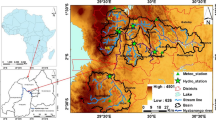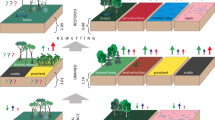Abstract
Vegetation type alters surface hydrology and nitrogen (N) cycling by partitioning evapotranspiration (ET) and drainage, but has not been fully utilized for this purpose in the design of urban rain gardens. Replicated treatments of three vegetation types (prairie, shrub, and turfgrass) commonly planted in rain gardens, as well as bare soil (control), were evaluated 1 year after establishment in 12, free-drainage bioretention cells designed to specifications for residential rain gardens in the Midwestern United States. Water and N budgets were calculated to assess differences in ET, drainage, soil moisture, and N transport following three stormwater applications in July, August, and October of 2006. Evaporative demand was also estimated as potential or reference ET during the study period using Hamon, Priestley-Taylor, and FAO Penman-Monteith models. Results show that after 1 year of establishment, vegetation type changed the water budgets of rain gardens thus altering their provisioning of ecosystem services via observed tradeoffs between daytime evaporative cooling (ET), stormwater storage, N-load reduction, soil and plant N retention, and groundwater recharge (drainage). Vegetation effects on hydrology and N transport were most significant when evaporative demand was high during the middle of the growing season. Observed changes in ET, drainage, soil moisture, and N transport support the incorporation of different vegetation types into conceptual and numerical models of rain gardens to assess ecological outcomes and tradeoffs at a variety of spatiotemporal scales.








Similar content being viewed by others
References
Abdou HM, Flury M (2004) Simulation of water flow and solute transport in free-drainage lysimeters and field soils with heterogeneous structures. Eur J Soil Sci 55:229–241
Allen RG, Pereira LS, Raes D, Smith M (1998) Crop evapotranspiration: Guidelines for computing crop water requirements. FAO Irrigation and Drainage Paper. GAO, Rome
Angers DA, Caron J (1998) Plant-induced changes in soil structure: processes and feedbacks. Biogeochemistry 42:55–72
Arnold CL, Gibbons CJ (1996) Impervious surface coverage: the emergence of a key environmental indicator. J Am Plann Assoc 62:243–258
Bannerman RT, Considine E (2003) Rain gardens: a how-to manual for homeowners. Wisconsin Dept. of Natural Resources: University of Wisconsin-Extension, Madison, PUB-WT-776
Brown RA, Skaggs RW, Hunt WF (2013) Calibration and validation of DRAINMOD to model bioretention hydrology. J Hydrol 486:430–442
Brye K, Norman J, Bundy L, Gower S (2000) Water-budget evaluation of prairie and maize ecosystems. Soi Sci Soc Am J 64:715–724
Burt R (1996) Soil survey laboratory methods manual. Version 3.0 edn. USDA
Carpenter D, Hallam L (2010) Influence of Planting Soil Mix Characteristics on Bioretention Cell Design and Performance. J Hydrol Eng 15:404–416. doi:10.1061/(ASCE)HE.1943-5584.0000131
Carpenter SR, Bennett EM, Peterson GD (2006) Scenarios for ecosystem services: an overview. Ecol Soc 11:29
Carpenter SR, Booth EG, Gillon S, Kucharik CJ, Loheide S, Mase AS, Motew M, Qiu J, Rissman AR, Seifert J (2015) Plausible futures of a social-ecological system: Yahara watershed, Wisconsin, USA. Ecol Soc 20:10
Clark C, Busiek B, Adriaens P (2010) Quantifying thermal impacts of green infrastructure: Review and gaps. Proc Water Environ Federation 2:69–77
Davis AP (2008) Field performance of bioretention: Hydrology impacts. J Hydrol Eng 13:90–95. doi:10.1061/(ASCE)1084-0699(2008)13:2(90)
Davis AP, Traver RG, Hunt WF, Lee R, Brown RA, Olszewski JM (2011) Hydrologic performance of bioretention storm-water control measures. J Hydrol Eng 17:604–614
Demuzere M, Orru K, Heidrich O, Olazabal E, Geneletti D, Orru H, Faehnle M (2014) Mitigating and adapting to climate change: Multi-functional and multi-scale assessment of green urban infrastructure. J Environ Manage 146:107–115
Denich C, Bradford A (2010) Estimation of evapotranspiration from bioretention areas using weighing lysimeters. J Hydrol Eng 15:522–530
Diak GR, Anderson MC, Bland WL, Norman JM, Mecikalski JM, Aune RM (1998) Agricultural management decision aids driven by real-time satellite data. Bull Am Meteorol Soc 79:1345–1355
Dietz M, Clausen J (2005) A field evaluation of rain garden flow and pollutant treatment. Water Air Soil Poll 167:123–138. doi:10.1007/s11270-005-8266-8
Doherty JM, Miller JF, Prellwitz SG, Thompson AM, Loheide SP II, Zedler JB (2014) Hydrologic regimes revealed bundles and tradeoffs among six wetland services. Ecosystems 17:1026–1039
Dunn AD (2010) Siting green infrastructure: legal and policy solutions to alleviate urban poverty and promote healthy communities. BC Envtl Aff L Rev 37:41
Dussaillant AR, Wu CH, Potter KW (2004) Infiltration of Stormwater in a Rain Garden: Richards Equation Numerical Model and Field Experiment. P Int Environ Modell Softw Soc 3:1105–1110
Endreny T (2008) Naturalizing urban watershed hydrology to mitigate urban heat-island effects. Hydrol Process 22:461–463
Gee GW, Or D (2002) Particle-size analysis. Methods of soil analysis. Part 4. Physical methods. SSSA, Madison, pp 255–293
Gilchrist S, Borst M, Stander EK (2013) Factorial Study of Rain Garden Design for Nitrogen Removal. J Irrig Drainage E-ASCE 140:04013016
Gill SE, Handley JF, Ennos AR, Pauleit S (2007) Adapting cities for climate change: the role of the green infrastructure. Built Environ 33:115–133
Gober P, Brazel A, Quay R, Myint S, Grossman-Clarke S, Miller A, Rossi S (2009) Using watered landscapes to manipulate urban heat island effects: how much water will it take to cool Phoenix? J Am Plann Assoc 76:109–121
Hamon WR (1963) Computation of direct runoff amounts from storm rainfall. Int Assoc Sci Hydrol Pub 63:52–62
Hatt B, Fletcher T, Deletic A (2009) Hydrologic and pollutant removal performance of stormwater biofiltration systems at the field scale. J Hydrol 365:310–321. doi:10.1016/j.jhydrol.2008.12.001
He Z, Davis AP (2010) Process modeling of storm-water flow in a bioretention cell. J Irrig Drain E-ASCE 137:121–131
Heiri O, Lotter AF, Lemcke G (2001) Loss on ignition as a method for estimating organic and carbonate content in sediments: reproducibility and comparability of results. J Paleolimnol 25:101–110
Hickman J, Wadzuk B, Traver R (2011) Evaluating the role of evapotranspiration in the hydrology of a bioinfiltration basin using a weighing lysimeter. Reston, VA: proceedings of the 2011 world environmental and water resources congress; May 22 26, 2011, Palm Springs, California| d 20110000. ASCE
Houdeshel CD, Hultine KR, Johnson NC, Pomeroy CA (2015) Evaluation of three vegetation treatments in bioretention gardens in a semi-arid climate. Landscape Urban Plan 135:62–72
Hsieh C, Davis A (2005) Evaluation and optimization of bioretention media for treatment of urban storm water runoff. J Env Eng-ASCE 131:1521–1531. doi:10.1061/(ASCE)0733-9372(2005)131:11(1521)
Hunt W, Jarrett A, Smith J, Sharkey L (2006) Evaluating bioretention hydrology and nutrient removal at three field sites in North Carolina. J Irrig Drain E-ASCE 132:600–608. doi:10.1061/(ASCE)0733-9437(2006)132:6(600)
Hunt, WF, Lord, B, Loh B, Sia A (2015) Selection of plants that demonstrated nitrate removal characteristics. In Plant selection for bioretention systems and stormwater treatment practices. Springer Singapore: 7–20
Johnsson H, Bergstrom L, Jansson P-E, Paustian K (1987) Simulated nitrogen dynamics and losses in a layered agricultural soil. Agric Ecosyst Environ 18:333–356
Johnston MR (2005) Effects of prairie gardens on the physical propertis of urban soil in Madison, WI. M.S. Thesis. Univ. of Wisconsin, Madison
Johnston MR (2011) Vegetation type alters rain garden hydrology through changes to soil porosity and evapotranspiration. Ph.D. diss. Univ. of Wisconsin, Madison
Johnston MR, Balster NJ, Zhu J (2016) Impact of residential prairie gardens on the physical properties of urban soil in Madison, Wisconsin. J Environ Qual 45:45–52
Kim H, Seagren EA, Davis AP (2003) Engineered bioretention for removal of nitrate from stormwater runoff. Water Environ Res 75:355–367
Le Coustumer S, Fletcher TD, Deletic A, Barraud S, Poelsma P (2012) The influence of design parameters on clogging of stormwater biofilters: A large-scale column study. Water Res 46:6743–6752
Li L, Davis AP (2014) Urban stormwater runoff nitrogen composition and fate in bioretention systems. Environ Sci Technol 48:3403–3410
Li H, Sharkey LJ, Hunt WF, Davis AP (2009) Mitigation of impervious surface hydrology using bioretention in North Carolina and Maryland. J Hydrol Eng 14:407–415
Lu J, Sun G, McNulty SG, Amatya DM (2005) A comparison of six potential evapotranspiration methods for regional use in the southeastern United States. J Am Water Resour Assoc 41:621–633
Mangangka IR, Liu A, Egodawatta P, Goonetilleke A (2015) Performance characterisation of a stormwater treatment bioretention basin. J Environ Manage 150:173–178
McPhillips L, Walter MT (2015) Hydrologic conditions drive denitrification and greenhouse gas emissions in stormwater detention basins. Ecol Eng 85:67–75
Mikutta R, Kleber M, Kaiser K, Jahn R (2005) Review. Soil Sci Soc Am J 69:120–135
Mitchell VG, Cleugh HA, Grimmond CSB, Xu J (2008) Linking urban water balance and energy balance models to analyse urban design options. Hydrol Process 22:2891–2900
Pataki DE, Carreiro MM, Cherrier J, Grulke NE, Jennings V, Pincetl S, Pouyat RV, Whitlow TH, Zipperer WC (2011) Coupling biogeochemical cycles in urban environments: ecosystem services, green solutions, and misconceptions. Front Ecol Environ 9:27–36
Potter KW (2006) Small-scale, spatially distributed water management practices: Implications for research in the hydrologic sciences. Water Resour Res 42(3)
Priestley C, Taylor R (1972) On the assessment of surface heat flux and evaporation using large-scale parameters. Mon Weather Rev 100:81–92
Prince George’s County (1993) Design Manual for Use of Bioretention in Stormwater Management. Prince George’s County (MD) Government, Department of Environmental Protection. Watershed Protection Branch, Landover
Raudsepp-Hearne C, Peterson GD, Bennett EM (2010) Ecosystem service bundles for analyzing tradeoffs in diverse landscapes. Proc Natl Acad Sci U S A 107:5242–5247
Read J, Wevill T, Fletcher T, Deletic A (2008) Variation among plant species in pollutant removal from stormwater in biofiltration systems. Water Res 42:893–902
Read J, Fletcher TD, Wevill T, Deletic A (2009) Plant traits that enhance pollutant removal from stormwater in biofiltration systems. Int J Phytoremediat 12:34–53
SAS Institute (2008) SAS Version 9.2 for Windows. Cary, North Carolina
Schatz J, Kucharik CJ (2014) Seasonality of the Urban Heat Island Effect in Madison, Wisconsin. J Appl Meteorol Climatol 53:2371–2386
Schatz J, Kucharik CJ (2015) Urban climate effects on extreme temperatures in Madison, Wisconsin, USA. Environ Res Lett 10:094024
Selbig WR, Balster N (2010) Evaluation of Turf-grass and Prairie-vegetated rain gardens in a clay and sand soil, Madison, Wisconsin, Water Years 2004–08. US Department of the Interior, US Geological Survey
Sharkey LJ (2006) The performance of bioretention areas in North Carolina: s study of water quality, water quantity, and soil media. M.S. thesis, North Carolina State Univ
Systat Software (2014) Sigma Plot version 13.0. San Jose, California, USA
Tanner CB (1957) Factors affecting evaporation from plants and soils. J Soil Water Conserv 12:221–227
Taylor GD, Fletcher TD, Wong TH, Breen PF, Duncan HP (2005) Nitrogen composition in urban runoff—implications for stormwater management. Water Res 39:1982–1989
Thompson A, Paul A, Balster N (2008) Physical and hydraulic properties of engineered soil media for bioretention basins. T ASABE 51:499–514
U.S. Census Bureau: State and County QuickFacts (2012) Data derived from population estimates, American Community Survey, census of population and housing, state and county housing unit estimates, county business patterns, nonemployer statistics, economic census, survey of business owners, building permits, consolidated federal funds report. http://quickfacts.census.gov/qfd/states/55000.html
United States Environmental Protection Agency (2012) What is green infrastructure? http://water.epa.gov/infrastructure/greeninfrastructure/gi_what.cfm
Wadzuk BM, Hickman JM Jr, Traver RG (2014) Understanding the Role of Evapotranspiration in Bioretention: Mesocosm Study. J Sustainable Water Built Environ 1:04014002
Yang H, Dick WA, McCoy EL, Phelan PL, Grewal PS (2013) Field evaluation of a new biphasic rain garden for stormwater flow management and pollutant removal. Ecol Eng 54:22–31
Acknowledgments
This work is a product of research supported by the United States Department of Agriculture Hatch (142) Formula Funding at the University of Wisconsin-Madison (Project No. WIS04947). We also acknowledge Watts Landscaping Inc. (Verona, WI) for their space, equipment, and field assistance. Additionally we acknowledge Drs. Birl Lowery, Marie Johnston, Ana Wells, and Ryosuke Fujinuma for assistance with experimental planning, statistics, and field instrumentation.
Author information
Authors and Affiliations
Corresponding author
Rights and permissions
About this article
Cite this article
Nocco, M.A., Rouse, S.E. & Balster, N.J. Vegetation type alters water and nitrogen budgets in a controlled, replicated experiment on residential-sized rain gardens planted with prairie, shrub, and turfgrass. Urban Ecosyst 19, 1665–1691 (2016). https://doi.org/10.1007/s11252-016-0568-7
Published:
Issue Date:
DOI: https://doi.org/10.1007/s11252-016-0568-7




